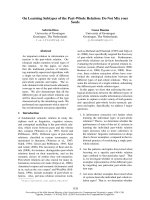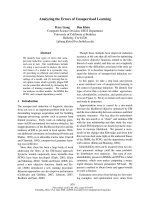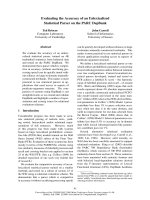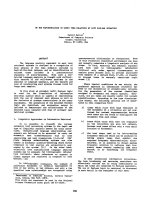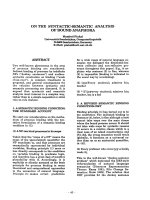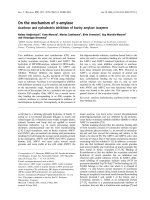Báo cáo khoa học: "On the Problem of Mechanical Translation" docx
Bạn đang xem bản rút gọn của tài liệu. Xem và tải ngay bản đầy đủ của tài liệu tại đây (108.48 KB, 2 trang )
[
Mechanical Translation
, vol.3, no.2, November 1956; pp. 42-43]
On the Problem of Mechanical Translation
†
D. Panov, The Academy of Sciences, Moscow, U.S.S.R.
HAVING STARTED WORK on mechanical trans-
lation, we arrived at the conclusion that both
the lexical meaning and the morphological shape
of the word can and should be utilized in analy-
zing the text, and that for purposes of transla-
tion it is impractical to omit the information
which can be thus obtained. The utilization of
the lexical meanings of words as well as of
their contexts may also affect problems of cod-
ing. These questions are extremely important
to automatic translation.
We based our work on the following principles:
1.
Maximum separation of the dictionary from
the translation program. This enables us to
enlarge the dictionary easily without changing
the program.
2.
Division of the translation program into two
independent parts: analysis of the foreign lan-
guage sentence and synthesis of the correspond-
ing Russian sentence. This enables us to uti-
lize the same Russian synthesis program in
translation from any language.
3.
Storing all the words in the dictionary in
their basic form. This enables us to design
the program for synthesis of the Russian text
according to the standard rules of Russian
grammar.
4.
Storing in the dictionary all the constant
grammatical properties of words.
5.
Determination of multiple meanings of the
words from the context, whereas their variant
grammatical characteristics are determined by
analyzing the grammatical structure of the
sentence.
These principles have proved quite reliable
in the practice test to which they were subjected.
Hence it seems to us that they constitute a re-
liable basis for the solution of the problem of
MT.
The contents of the dictionary, for our expe-
riments, were determined by an analysis of
mathematical textual material, starting with
Milne's "Numerical Solution of Differential
Equations". For the practical experiments,
which were carried out on the BESM (the USSR
Academy of Sciences' high-speed electronic
† Translated by M. Friedman and M. Halle, MIT.
computer), a dictionary of 952 English and
1,073 Russian words was compiled.
For a number of English words (121 words,
in our case), the place-in-the-vocabulary indi-
cation is replaced by special digit indication to
show that these words have multiple meaning.
The proper Russian word is chosen in this case
by utilizing a special program of automatic
translation, which we call "the Polysemantic
Dictionary".
If the spelling of the word in the text coincides
exactly with that of a word in the dictionary, i.
e
.,
their numerical codes coincide, this fact
can easily be established by the operation of
matching. This is the principle used for find-
ing words in the dictionary.
In order to find words in the dictionary which
possess an affix (say, 's' or 'ing' or 'ed'), the
machine must discard these endings after which
it must repeat the search for the word with the
discarded affix.
To determine the meaning of a polysemantic
word, the words surrounding it in the given
sentence are analyzed. Both the semantic and
the grammatical characteristics are established.
The routines for determining the particular
meaning of a polysemantic word are based on
an elaborate analysis of a great body of con-
crete material and are placed together in a
special part of the translation program called
the "polysemantic dictionary". Idiomatic ex-
pressions are also included in this part of the
program.
It should be noted that the establishment of
the most simple and general criteria for deter-
mining a particular meaning of a word (or group
of words) is the result of substantial prelimi-
nary work by our linguists on actual texts.
If a word in the sentence to be translated is
not found in the dictionary, it is stored unaltered
in the memory of the machine. When the trans-
lated sentence is printed out, such a word will
be printed in Latin script.
Investigations in the area of the dictionary
are fairly extensive. In our group they have
been carried out by L.N. Korol'ev.
Of great importance is the space that a dic-
tionary occupies in the memory. A method of
"code compression" devised by L.N. Korol'ev
Problems of Mechanical Translation 43
considerably reduces this space.
The automatic translation program is divided
into two main parts — analysis and synthesis.
In the first part, the form of the English
words, their place in the sentence, and the
grammatical information given in the dictionary
are analyzed with a view to the determination
of both the grammatical form of the correspond-
ing Russian words and their place in the Russian
sentence. The resulting information is record-
ed by means of indices, thereby permitting
passage to the second part of the program
"Synthesis of the Russian Sentence". Here,
Russian words, taken from the dictionary in
their basic form, acquire grammatical form
in accordance with the indices obtained from
the analysis.
Both English and Russian grammar is pre-
sented as a series of special schemes for the
basic parts of speech: verbs, nouns, adjectives,
numerals, etc. The working basis of each
scheme is dichotomic analysis, i.e., a system
of "checking" for the presence or absence of a
certain grammatical (morphological or syn-
tactical) characteristic of the analyzed word.
In checking, only two answers are possible,
either positive or negative. Each of these
answers admits either a final conclusion and
the development of the corresponding gramma-
tical indices for the given word, or the continu-
ation of the check for the presence of the next
characteristic until a definitive answer is ob-
tained together with an indication of which
grammatical indices must be developed for the
given word.
Different parts of the program are ordered
in a sequence which ensures the development
of the indices necessary to carry out further
operations.
Starting with the input of the English sentence
into the machine, the entire translation process
has been carried out automatically with no
human intervention whatsoever. To make the
machine translate in the manner just described,
an enormous amount of preliminary research
work by philologists was required especially
by I.K. Belskaya, our philologist-in-chief,
and by the mathematicians I. S. Mukhin, L.N.
Korol'ev, S.N. Razumovskii, G.P. Zelenke-
vich, and, in the early stages, N.P. Trifonov.
S.N. Razumovskii has been studying transla-
tion schemes and programs and their logical
structure. He has developed a system of sym-
bols that makes possible the recording of the
details of the above mentioned schemes in an
appropriate manner.
Our opinion is that the principles according
to which machine translation of languages
should be organized have been sufficiently cla-
rified by now and that the time is ripe to under-
take work on a large scale. We have started
research work in automatic translation from
German, Chinese, and Japanese into Russian.
In our discussions of machine translation
from Chinese and Japanese, we thought that
great difficulties would be presented by the in-
put in these languages. However, this problem,
apparently, will be solved easily by using the
Chinese telegraph code.
The work on German is being carried out
under the direction of Belskaya by G. P. Zelen-
kevich and E. A. Khodzinskaya; Chinese by A.
A, Zvonov and V. A. Voronin; and Japanese by
M. B. Efimov.
We also plan soon to take up the problem of
translation from one foreign language into
another. For this we intend to use Russian as
the "inter-language".

